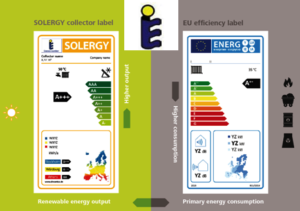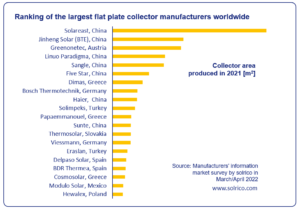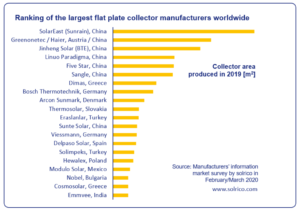Solar Keymark: Additional Table Allows Comparison of Annual Collector Output
October 1, 2012 The Solar Keymark certification is getting more consumer-friendly: Since the beginning of this year, the new certificate data sheets include a second page on the annual collector unit output for different solar radiation sites in Europe (Stockholm, Davos, Würzburg and Athens). The list shows the output at average collector temperatures of 25, 50 and 75 °C. For example: The new optimised Aqua Plasma collector 19/17 by German collector producer Ritter achieves 1,106 kWh per collector unit and year in Würzburg (50 °C). The gas-filled flat plate collector PS1-52 Joule by Austrian company Geo-Tec achieves 793 kWh at the same location. Both collectors were launched this year with a gross collector area of 1.69 m² and were presented at the Intersolar Europe in June. The listed output should now give end consumers a good hint at what they get for their money.
The Solar Keymark certification is getting more consumer-friendly: Since the beginning of this year, the new certificate data sheets include a second page on the annual collector unit output for different solar radiation sites in Europe (Stockholm, Davos, Würzburg and Athens). The list shows the output at average collector temperatures of 25, 50 and 75 °C. For example: The new optimised Aqua Plasma collector 19/17 by German collector producer Ritter achieves 1,106 kWh per collector unit and year in Würzburg (50 °C). The gas-filled flat plate collector PS1-52 Joule by Austrian company Geo-Tec achieves 793 kWh at the same location. Both collectors were launched this year with a gross collector area of 1.69 m² and were presented at the Intersolar Europe in June. The listed output should now give end consumers a good hint at what they get for their money.
“The additional datasheet with the annual collector output means taking an important step towards a Europe-wide uniform criterion for the performance characterisation of collectors,” Harald Drück, Chairman of the Solar Keymark Network, explains. “We have been thinking about this step for a long time. But, we first had to agree on how to calculate the output.” The idea finally turned into a reality at the Solar Keymark meeting in spring 2011. Peter Kovacs, researcher at the Technical Research Institute of Sweden (SP), presented his Excel-based calculation tool at that meeting. Radiation data from four cities across Europe were chosen. The three different average collector temperatures stand for different application areas: A collector mean temperature of 25 °C is used in low-temperature areas, such as swimming pool heating. A collector temperature of 50 °C is typical for space heating and hot water production. An average collector temperature of 75 °C covers the medium temperature range of process heat or solar cooling.
“We all agreed that the additional table in the certificate was to include solar yields related to the entire collector system – independent of its gross collector area,” explains Drück. Since the beginning of this year, all Solar Keymark certificates have been published with an added collector performance table. The following table shows the performance data of different collector types which have roughly the same gross collector area. Because the methodology is still new, some of the market leaders in Europe, such as Bosch, Viessmann Germany, Wagner, Solvis and Vaillant, have not yet Solar Keymark certificates for their collectors with the second page.
|
Collector module |
Collector type |
Manufacturer |
Gross collector area (m²) |
Annual collector output in Würzburg at 50 °C average collector temperature |
Annual collector output in Würzburg at 75 °C average collector temperature |
|
Aqua Plasma 19/34 |
Double glass evacuated vacuum tubes with CPC mirror |
Ritter, Germany |
3.35 |
2,227 kWh |
2,015 kWh |
|
Thermomax DF 400 30 |
Metal-glass vacuum tube collector without CPC |
Kingspan, Ireland |
4.15 |
2,274 kWh |
1,886 kWh |
|
|
|
|
|
|
|
|
DIS25 (Vitosol 200 BV 0,5) |
Flat plate collector |
Viessmann Poland |
2.64 |
1,217 kWh |
685 kWh |
|
RF 258s (KT08_04_5) |
Flat plate collector |
REM GmbH, Germany |
2.58 |
935 kWh |
512 kWh |
|
|
|
|
|
|
|
|
TZ58/1800-15G |
Vacuum tube collector |
Sunrain, China |
2.64 |
1,193 kWh |
993 kWh |
|
TPH-18/18 |
Vacuum tube collector |
Tianpu, China |
2.69 |
972 kWh |
634 kWh |
For example, the new and optimised Aqua Plasma collector needs 20 % less collector gross area to achieve the same output as a Kingspan vacuum tube collector. The two, almost same-sized, flat plate collector models show how output can vary between 935 kWh and 1,217 kWh per collector (50 °C, Würzburg). The last two sets in the chart show the great difference even among Chinese vacuum tube collectors, between 1,193 kWh and 972 kWh per collector (50 °C, Würzburg). The new performance indicator has to be viewed in relation to the end consumer price.
It lets the end consumer calculate an investment per annual kWh produced heat and take this figure into account when making his decision.
More information:
http://www.estif.org/solarkeymarknew/


